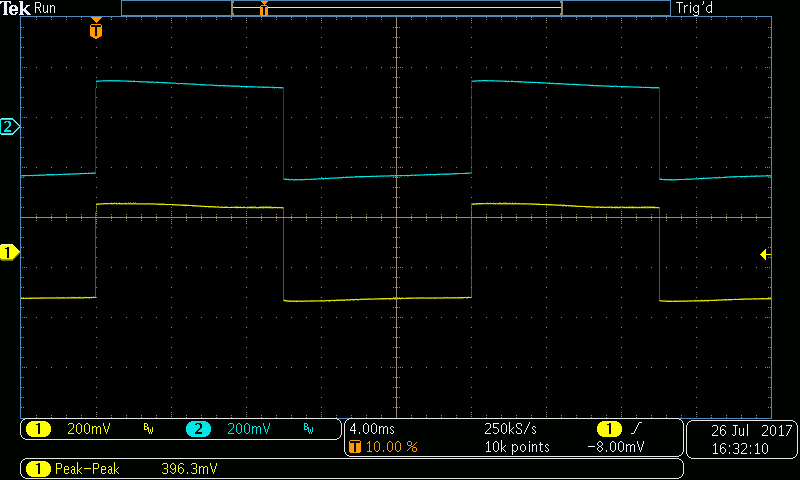Your basket is currently empty!

Hifisonix Accurate Inverse RIAA Network
The diagram above summarizes the interaction of the cutting head response (purple) and the playback EQ (red) which produces the final flat response (green). Note that the cutting head and the phono pickup (cartridge) are velocity transducers and therefore the cartridge output rises at 20 dB/decade if the record groove is cut at constant amplitude.
Click here to buy a set of 2 Inverse RIAA PCB’s over in the shop
Designing and engineering RIAA equalizers demands a clear understanding of the signal chain requirements during the development process. Once components have been committed to a prototype PCB however, testing is required. Presented here is a simple Inverse RIAA Network, or IRN, that allows testing to be quickly and effectively done.
It is important that the RIAA equalizer response is accurate across the audio band (20 Hz to 20 kHz) and also well behaved beyond that. The usefulness of this simple tool can be gauged by the fact that, after building an RIAA EQ amp based on a design published by one of the foremost exponents of the art, testing revealed that whilst its sine wave response conformity from 20 Hz to 20 kHz was exemplary, the gain at 500 kHz was 8 dB higher that at 20 kHz, which manifest as overshoot on the square wave tests. Some simple mods to the RIAA network resolved the problem, and the response was then flat out to ~50 kHz, after which it dropped off ultimately approaching at 20 dB/decade at 200 kHz
Here is the article: Accurate Inverse RIAA
Pictured below is the conformity of a high performance phono amp using the IRN. The reading was taken with a QuantAssylum 401 measurement DAC/ADC set to 20 to 100 kHz display bandwidth sampling at 24bit/192 kHz.

Above: 20 Hz to 100 kHz frequency sweep response of RIAA amplifier fed through the IRN
Note in the picture above, the drop off in response below 100 Hz is due to the analyser response, and not the RIAA equalizer which is flat down to 20 Hz (rumble filter switched OUT).
The scope screen shots that follow (which are for the same RIAA amplifier) show how easy it is to test an RIAA EQ amp using just an IRN and a square wave stimulus. In the first picture, we see the performance at 20 Hz. The waveform tops/bottoms show a small amount of slope which is caused by a slight roll-off at 20 Hz (around 0.3 dB in this particular design).

Above: RIAA EQ response to a 20 Hz square wave input stimulus fed via the IRN.
The shot below is for a 2 kHz square wave input stimulus. Since the square wave stimulus contains harmonics that are accurately amplitude related to the 2 kHz fundamental, this result implies that the response is accurate to at least 10 kHz (5th harmonic). The amplitude of the harmonics beyond 10 kHz is low, and therefore it is difficult to infer a high degree of accuracy above this frequency. Testing therefore has to take place at higher stimulus frequencies to confirm this.

Above: RIAA EQ output with a 2 kHz input stimulus fed via the IRN.
The shot below is for a 20 kHz square wave stimulus. The response is still remarkably good and in accordance with the results shown in the frequency sweep shown earlier. Since there is slight rounding of the edges, we can infer that the response has started to drop off above about 50 kHz.

Above: The response of a high conformity RIAA stage to a 20 kHz square wave input stimulus via the IRN.
Finally, the plot below shows the performance with a 50 kHz stimulus. The edges are rounded showing that the response is dropping off in a controlled manner (i.e. no overshoot or HF response anomalies) in accordance with the design requirements.

Above: RIAA EQ amp with 50 kHz square wave input stimulus fed via the IRN.
Comments
10 responses to “Hifisonix Accurate Inverse RIAA Network”
-
Hello Hans
I will have to take a look at this when I get back from my travels
Rgds
Andrew -
How to modify the input stage to accommodate for a line-level audio input? Should also make a way better aux to phono adapter than the usual ones out there, to use some more inputs on amps… Best, Hans
-
Hello James, its just the blank PCB (2 off supplied). The BOM is for parts from Mouser.
Regards
Andrew
-
Hi there, just wondering, the Inverse RIAA pcb sold in your shop, are there just plain PCB or does it already populated with the SMD components? Thanks, James.
-
Yes, minimum order is 5 pcs unfortunately
-
Unfortunately, they want $75 for 5 PCB’s, which is a bit much.
-
Hi,
I’ve never done V cut boards – always routed. I use PCB cart in China – maybe they can help. You can get an online quote on their website in about 3 minutes. -
Hi,
I have sent the Gerbers to a few manufacturers and they wont make them and have replied with very similar messages to this one:
“Hi Sir/Madam,
Sorry to tell you that the minimum V-cut boards we can make is 70mm*70mm to get through the v-cut machine and your board is not big enough for us to make it.”
Any advice?
-
Hello,
sorry I cannot read Danish – apologies. If you want the IRN Gerbers, you are welcome to them – just go ahead and download the file in the Inverse RIAA network article.
-
[…] at denne kretsen er bra nok. +/- 0.5 dB er dessverre ikke det, så jeg fant denne fra HIFISonix: An Accurate Inverse RIAA Network Den er ikke til salgs, men kretsskjema og gerbers finnes. Jeg har gjort en egen, i stereo, med […]

Leave a Reply